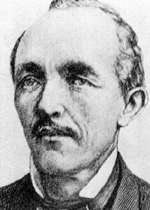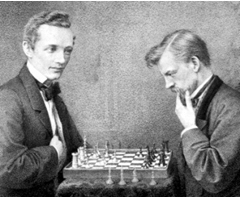Paulsen Louis (15.01.1833 – 18.09.1891)
 One of the great chess theoreticians and a player ranking among the world’s best half-dozen in the 1860s and 1870s. Born in Nassengrund, Germany, to a chess-playing family, he learned the game young but showed no special enthusiasm for it at the time.
One of the great chess theoreticians and a player ranking among the world’s best half-dozen in the 1860s and 1870s. Born in Nassengrund, Germany, to a chess-playing family, he learned the game young but showed no special enthusiasm for it at the time.
In 1854, he joined his brother Ernst’s tobacco business in Iowa, USA. Louis entered America’s first important tournament, New York 1857, and took second place after Morphy. Then he began to take chess seriously, although he remained an amateur throughout his life. He built up a reputation as a blindfold expert, achieving the unprecedented feat of playing fifteen opponents simultaneously (although his usual number was ten), and he studied ‘…with such zeal that I don’t like to lose five minutes of time’. For two years he tried in vain to arrange a match with Morphy, and in the autumn of 1860 he returned home to work in the family agricultural business. (It included a distillery; Paulsen himself was a lifelong teetotaler and non-smoker).
Best results: Bristol 1861, ahead of Kolisch; London 1862, second to Anderssen; Hamburg 1869, second to Anderssen after a play-off; Leipzig 1877, first (+9=2), ahead of Anderssen, Zukertort and Winawer; Frankfurt 1878, first; and Leipzig 1879, second, after English. Paulsen’s style was better suited to match play, at which he was undefeated. He drew with Anderssen in 1862 (+3=2-3) and led Kolisch (+7=18-6) in an unfinished match, 1861. He defeated Neumann in 1864 (+5=3-2), Anderssen in 1876 (+5=1-4) and again in 1877 (+5=1-3), and Schwarz in 1879 (+5-2). In the two longest events in which he participated – the two Vienna Congresses of 1873 and 1882 – he made fine plus scores (+14-9=4 and +13-10=11 respectively) and finished sixth and eighth. His last tournament was in Breslau 1889 when he shared fourth place – no mean achievement, for he was already suffering from diabetes that caused his death.

Match Paulsen-Lange, Leipzig 1864
Quiet and unassuming, Paulsen was a thinker rather than a doer. ‘He is extremely difficult’, wrote Staunton, ‘rarely speaking unless spoken to.’ Paulsen discovered a larger number of opening ideas than any of his contemporaries.
For the attack, he contributed to the Scotch Game, the Goering Gambit, the Paulsen Attack, the Paulsen Variations of the Vienna Game and for the Four Knights Opening. For the Defence, he discovered the Boleslavsky Variation, the Paulsen Defence of the Kieseritsky Gambit, and the Paulsen Variation of the Sicilian Defence. He introduced the Pirc Defence and improved Black’s chances in the Muzio Gambit and in several lines of the Sicilian Defence. His contributions were not confined to an odd move or random improvements: he also invented whole systems of play. He introduced 3 Nc3 (after 1 e4 e6 3 d4 d5) in the French Defence, a move that revitalized white’s prospects when no one else could think of anything better than 3 exd5, and he experimented with 3 e5, later adopted by Nymzowitsch. From the Normal Position of the Evans Gambit, he developed a defensive system that is still regarded as the best, and he introduced the Fianchetto in many openings. The architect of the Sicilian Defence, he invented the Dragon Variation, which remains popular, and he pioneered the King’s Indian Defence, still a much-played defense to the Queen’s Pawn Opening. He also worked out a defensive system against the then-popular Anderssen Variation of the Spanish Opening, a set-up successfully adopted by Steinitz in the thirteenth game of his match with Anderssen in 1866.
Of even greater consequence was Paulsen’s influence on the theory of the game: how the play should be conducted. Around 1860 most players sought direct attack, and they often obtained a considerable advantage when they had the first move. The much opening analysis was centered on white’s attacking possibilities, and most of Paulsen’s ideas were improvements for black. The first great master of defense, he believed that sound defenses were always possible, that black could maintain the equilibrium, that attacks by white would then fail; and on this understanding, the theory of play attributed to Steinitz was founded. In his games, Paulsen’s defensive notions often encouraged premature attacks. He would sometimes move pieces backward; surely, his contemporaries thought, this must be wrong. The first to realize that advantages might subsist in the possession of the two bishops, he would withdraw them to safe squares even if thereby aggravated his defensive difficulties. He was the great skeptic of his time. Like Lasker after him, he was aware of the need to re-examine all long-held assumptions. When Morphy offered to concede odds of pawn and move, Paulsen’s reply, that he wished to consider whether such odds might favor Black, was treated with derision; but it was not an unreasonable view, especially considering Morphy’s attacking skill, which might benefit materially by possession of the Half-Opened File. Being a deep strategist with a preference for the defense, he was not fully appreciated by his contemporaries and was always overshadowed by Morphy, Anderssen and Steinitz; his personal modesty and shyness helped to direct attention away from his achievements to the more radiant stars of his time. In later years one of his greatest admirers was Nimzowitsch, who recognized Paulsen as far ahead of his time.
Paulsen wrote no books, and none has been written that explains adequately his theoretical contributions. H. Paulussen, Louis Paulsen (1982), is a valuable collection of material on the whole Paulsen family, but two-thirds of the book relates to the subtitle, Das Schachspiel in Lippe 1900-1981, a topic of limited interest; Weltgeschichte des Schachs: Morphy and Paulsen (1967) contain 113 of Paulsen’s games.



